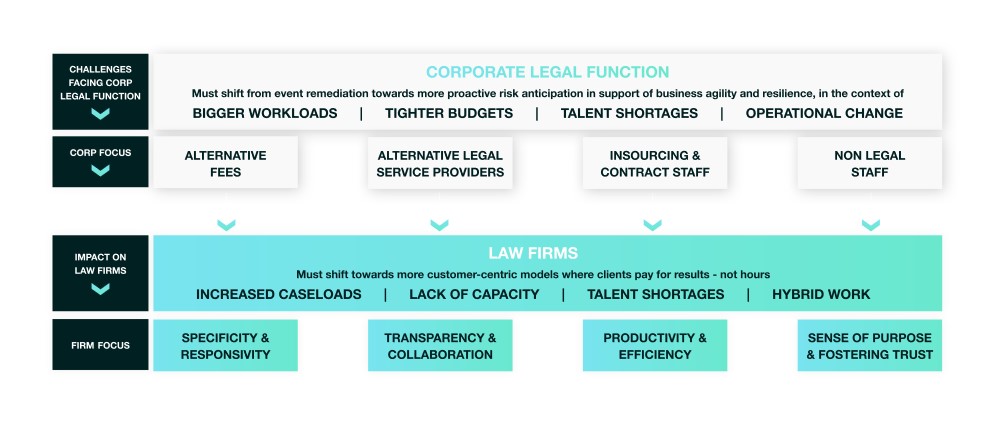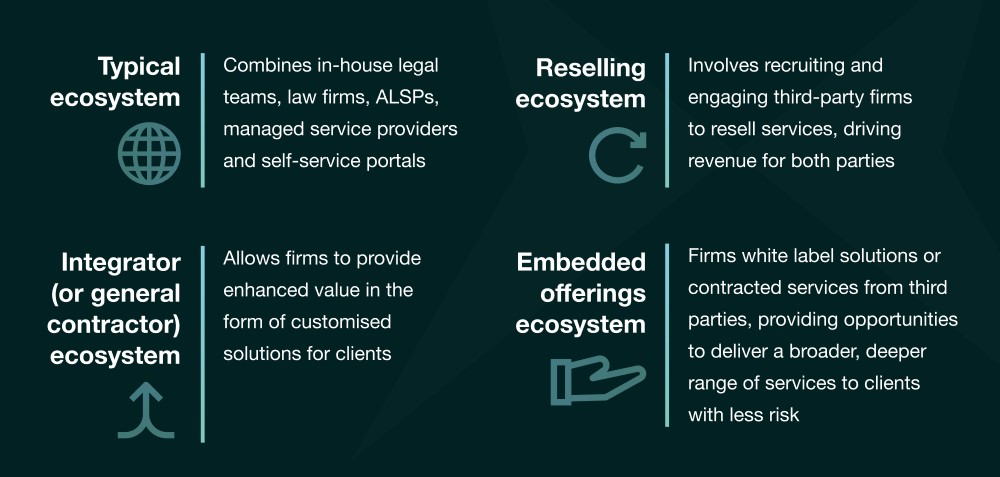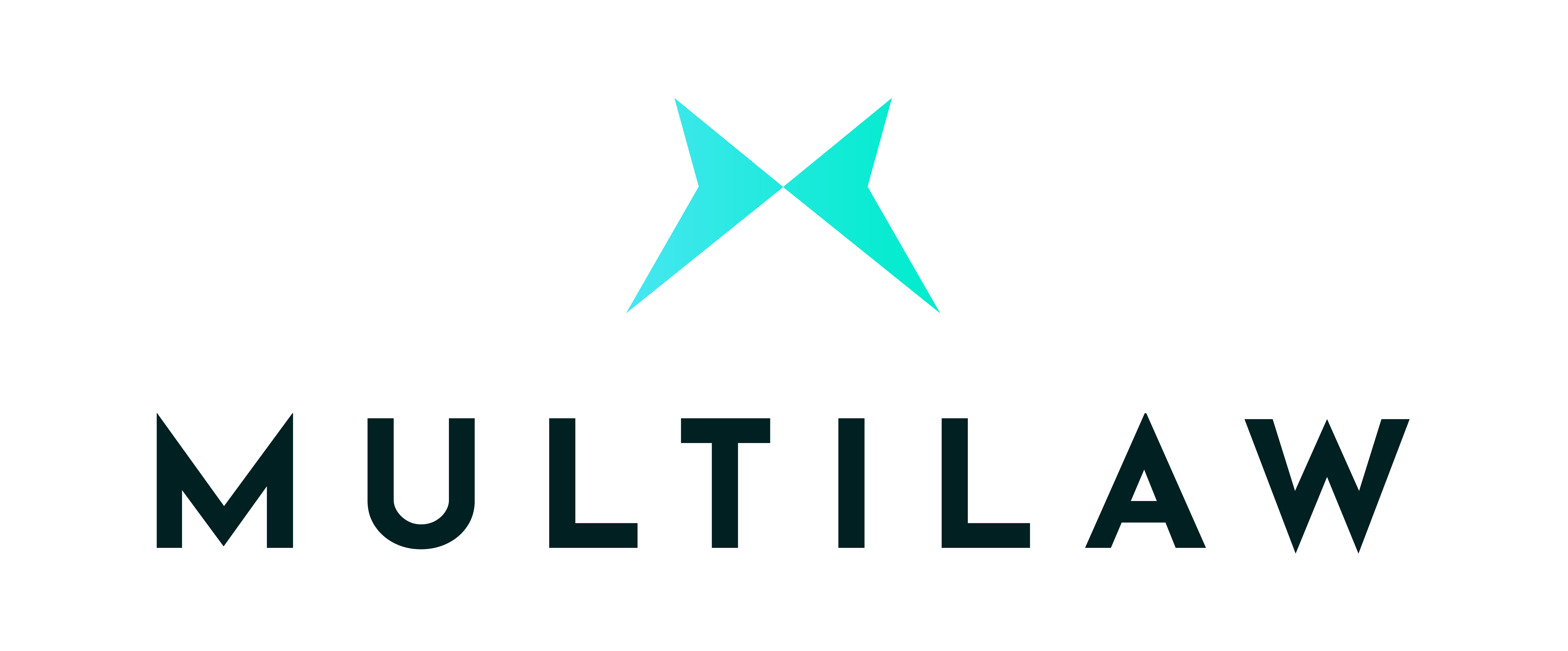The client-firm relationship is changing, fast
The client-firm relationship is evolving at an ever-increasing pace, with several macro-level trends combining to create conditions of continual disruption and change.
Businesses of all sizes, and in all markets and industries, are being buffeted by major headwinds, including:
● The volatile economic and geopolitical climate
● A changeable, fragmented and complex regulatory environment
● Significant shifts in societal expectations of businesses, and in employee values and behaviours
● Accelerating pace of tech-driven innovation and transformation
Strengthening foresight in the face of heightened risk
In response, corporate legal functions are being called upon to shift from event remediation towards more proactive risk anticipation in support of business agility and resilience, and to do so quickly.
But they’re facing some major headwinds of their own, which are in turn feeding through to their external partners and law firms (Figure 1).

Law firms must respond by becoming more efficient, effective, and tech-enabled
Against this backdrop, law firms, regardless of size or location, will need to sharpen their services and operations if they’re to remain profitable and competitive. This means investing in legal ops improvements to eradicate manual processes and tedious tasks.
By maximising available resources more effectively, firms can deliver more value to clients by accelerating time-to-market on new services and offerings, as well as delivering more strategic advice based on commercial acumen.
Law firms of the future will be expected to have efficient, flexible, tech-enabled services that have highly specific functions and support result-oriented commercial models.
Solution: A tale of two alternatives
Two changes to traditional operating models have emerged as key ways for law firms to respond to these challenges with more client-centric offerings: Alternative Legal Service Providers (ALSPs) and Alternative Fee Arrangements (AFAs).
In fact, the majority of legal teams — 79% of law firms and 71% of corporations, according to Thomson Reuters’ Alternative Legal Service Providers 2021 report — have already used ALSPs.
[79% of law firms have already used ALSPs]
And yet additional research indicates that their use is expected to grow significantly in the coming years.
Wolters Kluwer’s Future Ready Lawyer report found that 81% of law firms were expected to make greater use of third-party or outsourced resources in 2022, compared to 56% in 2020. The same report also found that 81% of legal firms and 86% of legal departments expect to make greater use of AFAs in 2022 compared to 74% and 72% respectively.
Benefits of ALSPs
In the past, many firms viewed ALSPs as direct competitors as they were able to perform the same routine services as their lawyers for lower cost. However, this attitude has changed over recent years with many now viewing them as collaborative partners who can alleviate manual tasks and give firms more time to focus on delivering value-led outcomes.
By providing, in the words of Gartner, “purpose-built delivery services that perform legal support work at a lower cost than traditional law firms and corporate legal departments,” ALSPs enable law firms to:
- Outsource time-consuming, low-value tasks and routine compliance, in order to utilise in-house talent more efficiently and strategically and, ultimately, maintain or increase margins.
- Ease recruitment and retention challenges, by dialling up and down access to specialist expertise or extra capacity, on demand.
- Accelerate access to efficiency-driving, advanced technologies, since ALSPs have made technology a key part of their offering. Contract management and process-mapping tools are among the most common solutions deployed by ALSPs, but many are beginning to leverage AI to automate more complex tasks, driving even greater value and efficiency.
Benefits of AFAs
Meanwhile, the increasing appeal of AFAs spans across the interests of both clients and law firm, to include:
- Greater billing transparency and predictability, allowing clients to better forecast budget requirements. In tightening economic times, this could be the deciding factor between law firms with similar skill sets and reputations.
- AFAs allow law firms to better predict work volumes and income month to month, compared to fluctuating monthly billable hours. This provides a steady cash flow and makes resource planning easier.
- More predictable and transparent billing also minimises the likelihood of time-consuming disputes over discrepancies and clarifications.
Adapt at speed with alternative solutions
For legal firms of all sizes and in almost every market, developing more customer-centric business models means augmenting their core competencies and offerings with communities of partners in order to deliver holistic solutions to clients.
As such, the value that ALSPs and AFAs can bring to law firms is best viewed through the lens of the legal ecosystems that will become more prominent over the next few years.
Emerging legal ecosystems
Figure 2 shows how ALSPs and AFAs can play a role in creating legal ecosystems that encourage stronger client engagement, smarter resource utilisation and increased knowledge sharing.

● Typical ecosystem
○ Combines in-house legal teams, law firms, ALSPs, managed service providers and self-service portals
● Reselling ecosystem
○ Involves recruiting and engaging third-party firms to resell services, driving revenue for both parties
● Integrator (or general contractor) ecosystem
○ Allows firms to provide enhanced value in the form of customised solutions for clients
● Embedded offerings ecosystem
○ Firms white label solutions or contracted services from third parties, providing opportunities to deliver a broader, deeper range of services to clients with less risk
Legal ecosystem benefits
- Ability to evolve legal delivery model
- Access to a diverse range of expertise and services
- Increased productivity
- Reduced cost/risk
- New routes to market
- Ability to scale at speed
Alternative Services Checklists
Regardless of size or location, any firm can benefit from ALSPs and AFAs. These checklists include just a few of the many examples of legal teams turning to these client-centric models.
Ideal tasks for ALSPs
ALSPs are key to law firms’ abilities to offer greater strategic value and become more agile organisations.
These example tasks show how they allow talent to be more effectively deployed, while also playing well into prevailing operational thinking on the client side around prioritising cost-effectiveness.
● On-demand staffing/capacity:
○ Highly skilled lawyers for specialist, limited duration projects
○ Or teams of junior lawyers for litigation document review
● Risk and compliance reviews
● Legal research
● Document review in discovery
● IP management
● Litigation/investigation support
● Contract drafting and review
● eDiscovery
● M&A due diligence
○
Checklist: types of AFA
AFAs take many forms, but while they’re becoming more common, widely accepted models are yet to be defined. Here are some of the most common examples found today, the range of which goes some way to illustrating why value-based billing is expected to be an important strategy for firms.
Fixed or flat fees: predetermined fees for specific services
● Capped fees: traditional hourly billing but with an agreed maximum
● Blended fees: agreed average hourly rate, applied regardless of lawyer seniority or experience
● Success or performance incentives: wins or specific outcomes trigger additional payments on top of agreed-upon minimum fee
● Unbundled legal services: clients choose specific tasks to handle themselves, while only paying firms for the aspects where they need specialist support
● Payment plans: agreed payment schedules that allow clients to spread the cost of their bill over a period of time
● Sliding scale fees: based on a client’s ability to pay, for example based on revenue for a business or income for a consumer
● Contingency fees: firms are paid a percentage of any payouts secured in successful cases
● Subscriptions: a standard, recurring fee for access to legal services (similar to a gym membership or a streaming service)
3 things to remember about ALSPs and AFAs
Driven by challenging geopolitical, economic, regulatory and societal factors and accelerated by innovative new technologies, corporate legal functions are rethinking operational models, reassessing resources and cutting cost and risk in the pursuit of greater resilience.
As we’ve seen, law firms can respond to these needs by turning to ALSPs for specialist skills, increased capacity and access to new technology, and adopting AFAs to increase billing transparency and predictability.
Ultimately, both operating models present a timely opportunity to reposition the client-firm relationship around maximising value; levelling up from providing legal services to business solutions, with meaningful — and measurable — outcomes.
To conclude, firms looking to grow their use of ALSPs and AFAs should consider three key things:
- ALSPs and AFAs play well into client requirements to maximise strategic value and cost-efficiency, and the need for firms to grow revenue and increase margins. And here’s the proof — the Future Ready Lawyer Report, 2022, from Wolters Kluwer, reveals that when choosing the right law firm to work with, clients cite the following three categories of attributes as a key focus:
- Technology: to enable more productive, efficient, effective services
- Staffing/organisation: having the right talent and tools to do the job, productively, efficiently and effectively
- Client focus: value, capability and specialisation
- Macro trends around economic volatility are making the business case for AFAs stronger all the time, and particularly value-based fee structures. Firms can use AFAs to improve relationships with clients, by demonstrating their commitment to focussing on the results and outcomes that add the most value. Firms can also use AFAs to optimise their own operations, as an incentive to reduce inefficiency and increase productivity. But — firms must ensure that adoption of AFAs truly reflects clients’ needs rather than their own.
Check out the ACC’s 6 step framework for executing AFAs.
- Choosing an ALSP is a major decision. It takes serious care and consideration to select a partner that will integrate well with your team and enable you to keep delivering the quality your clients expect. So, take the time to: go deep on identifying the needs of your clients and your firm; ensure both clients and your staff understand what you’re doing and are fully prepared for any incoming changes; and make sure you’re clear on what success looks like.
